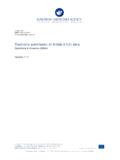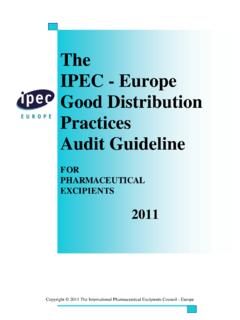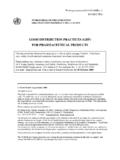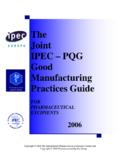Transcription of Guideline on good pharmacovigilance practices (GVP)
1 9 October 2017. EMA/827661/2011 Rev 1*. Guideline on good pharmacovigilance practices (GVP). Module IX Signal management (Rev 1). Date of coming into effect of first version 2 July 2012. Draft Revision 1* finalised by the Agency in collaboration with Member 30 June 2016. States Draft Revision 1 agreed by the European Risk Management Facilitation 18 July 2016. Group (ERMS FG). Draft Revision 1 adopted by Executive Director 4 August 2016. Release for public consultation 8 August 2016. End of consultation (deadline for comments) 14 October 2016. Revised draft Revision 1 finalised by the Agency in collaboration with 27 September 2017. Member States Revised draft Revision 1 agreed by the EU Network pharmacovigilance 4 October 2017. Oversight Group (EU-POG). Revised draft Revision 1 adopted by Executive Director as final 9 October 2017. Date for coming into effect of Revision 1* 22 November 2017**. ** Note: The requirement for marketing authorisation holders to monitor EudraVigilance data (Sections and ) and inform the Agency and national competent authorities of validated signals (Section ) will enter into force on 22 February 2018 and will only apply, for a transition period, to active substances contained in medicinal products included in the List of medicinal products under additional monitoring' in force as of 22 November 2017.
2 Please refer to dedicated communication from the Agency for more details. * Note: Revision 1 is a major revision with modifications throughout and contains the following: - Revised definition and process for emerging safety issues, previously addressed in GVP Module VI. ( and );. - Streamlined information on scientific aspects of signal management ( to ), statistical aspects now addressed in Addendum I;. See websites for contact details European Medicines Agency The European Medicines Agency is Heads of Medicines Agencies an agency of the European Union European Medicines Agency and Heads of Medicines Agencies, 2017. Reproduction is authorised provided the source is acknowledged. - Clarifications on terminology ( ), roles and responsibilities ( ) and processes (IX. Appendix 1);. - Updated guidance on the monitoring of EudraVigilance data ( );. - Guidance on signals detected by marketing authorisation holders based on the continuous monitoring of EudraVigilance data ( ).
3 Guideline on good pharmacovigilance practices (GVP) Module IX (Rev 1). EMA/827661/2011 Rev 1 Page 2/25. Table of contents Introduction .. 4. Terminology .. 4. General terminology .. 4. Terminology specific to the EU signal management process with oversight of the pharmacovigilance Risk Assessment Committee (PRAC) .. 6. Structures and 7. Sources of data and information .. 7. Signal detection .. 7. Evaluation during signal validation and further assessment .. 8. Signal prioritisation .. 9. Quality requirements .. 10. Operation of the EU 11. Roles and responsibilities .. 11. Responsibilities of the marketing authorisation holder in the EU .. 11. Responsibilities within the EU regulatory network .. 11. Emerging safety issues .. 12. Monitoring of EudraVigilance data .. 13. Principles for 13. Periodicity of monitoring .. 14. Analysis of EudraVigilance data .. 14. Notifications and procedural options for signals detected by the marketing authorisation holder in the EU based on the continuous monitoring of EudraVigilance data.
4 15. Variation of the terms of marketing authorisation .. 15. Inclusion of the signal in the periodic safety update report (PSUR) .. 16. Standalone signal notification .. 16. Signal confirmation by the PRAC rapporteur or (lead) Member State .. 17. Signal analysis, prioritisation and assessment by the PRAC .. 17. Recommendations on signals from the PRAC .. 18. Record management in the European pharmacovigilance Issues Tracking Tool (EPITT) .. 19. 19. IX. Appendix 1. Figures on the EU signal management process .. 21. Figure Notifications and procedural options for emerging safety issues and for signals detected by marketing authorisation holders based on the continuous monitoring of EudraVigilance data .. 21. Figure Confirmation process for standalone signal notifications from marketing authorisation holders .. 22. Figure Confirmation process for signals validated by the Agency or the competent authorities in Member States .. 23. Figure Process for analysis, prioritisation and assessment of signals by the PRAC.
5 24. Guideline on good pharmacovigilance practices (GVP) Module IX (Rev 1). EMA/827661/2011 Rev 1 Page 3/25. Introduction Regulation (EC) No 726/2004, Directive 2001/83/EC and Commission Implementing Regulation (EU). No 520/2012 (hereinafter referred to as REG, DIR and IR, respectively) include provisions for signal management in the European Union (EU) [DIR Art 107h, REG Art 28a, IR Chapter III]. In this Module, all applicable legal requirements are referenced as explained in the GVP Introductory Cover Note and are usually identifiable by the modal verb shall . Guidance for the implementation of legal requirements is provided using the modal verb should . The objectives of this Module are to: provide general guidance and requirements on scientific and quality aspects of signal management ( );. describe roles, responsibilities and procedural aspects in the setting of the EU signal management process overseen by the pharmacovigilance Risk Assessment Committee (PRAC) ( ).
6 This Module is applicable to medicinal products for human use authorised in the EU irrespective of the authorisation procedure (centralised or national procedure, including mutual recognition and decentralised). Unless stated otherwise, the guidance provided in the Module applies to all organisations involved in signal management, marketing authorisation holders, national competent authorities and the European Medicines Agency (the Agency'). Individual organisations may follow alternative signal management processes and terminology but should encompass the general principles outlined in this Module. An addendum to this Module, the GVP Module IX Addendum I, describes methodological aspects of signal detection from spontaneous reports of suspected adverse reactions. The following documents provide additional guidance relevant to signal management: Report of CIOMS Working Group VIII on Practical Aspects of Signal Detection in pharmacovigilance 1.
7 SCOPE Work Package 5 Signal Management - Best Practice Guide 2;. EMA Questions & Answers on Signal Management 3;. Screening for Adverse Reactions in EudraVigilance 4. Terminology Definitions relevant to signal management are also included in GVP Annex I. General terminology Signal: Information arising from one or multiple sources, including observations and experiments, which suggests a new potentially causal association, or a new aspect of a known association between 1. Council for International Organizations of Medical Sciences (CIOMS). Report of CIOMS Working Group VIII on Practical Aspects of Signal Detection in pharmacovigilance . Geneva: CIOMS; 2010. 2. See 3. See 4. See Guideline on good pharmacovigilance practices (GVP) Module IX (Rev 1). EMA/827661/2011 Rev 1 Page 4/25. an intervention and an event or set of related events, either adverse or beneficial, that is judged to be of sufficient likelihood to justify verificatory action [IR Art 19(1)].
8 New aspects of a known association may include changes in the frequency, distribution ( gender, age and country), duration, severity or outcome of the adverse reaction. A signal often relates to all medicinal products containing the same active substance, including combination products. Certain signals may only be relevant for a particular medicinal product or in a specific indication, strength, pharmaceutical form or route of administration whereas some signals may apply to a whole class of medicinal products. For the purpose of monitoring data in the EudraVigilance database (also referred to as EudraVigilance'), only signals related to an adverse reaction shall be considered [IR Art 19(1)]. Signal management process: A set of activities performed to determine whether, based on an examination of individual case safety reports (ICSRs), aggregated data from active surveillance systems or studies, scientific literature information or other data sources, there are new risks associated with an active substance or a medicinal product or whether known risks have changed, as well as any related recommendations, decisions, communications and tracking.
9 The EU signal management process includes the following activities: signal detection, signal validation, signal confirmation, signal analysis and prioritisation, signal assessment and recommendation for action [IR Art 21(1)] (see ). Signal prioritisation: The process, continuously performed throughout signal management, which aims to identify those signals suggesting risks with a potential important patients' or public health impact or which may significantly affect the risk-benefit balance of the medicinal product and thus require urgent attention and management without delay. 5. Signal detection: The process of looking for and/or identifying signals using data from any source. 6. Signal validation: The process of evaluating the data supporting the detected signal in order to verify that the available documentation contains sufficient evidence demonstrating the existence of a new potentially causal association, or a new aspect of a known association, and therefore justifies further analysis of the signal [IR Art 21(1)].
10 This evaluation should take into account the strength of the evidence, the clinical relevance and the previous awareness of the association (see ). The extent of evaluation performed during signal validation versus further assessment may vary according to the organisation's internal procedures. Validated signal: A signal for which the signal validation process has verified that the available documentation contains sufficient evidence demonstrating the existence of a new potentially causal association, or a new aspect of a known association, and therefore justifies further analysis of the signal. Non-validated signal: A signal for which the signal validation process has led to the conclusion that the available documentation at that point in time does not contain sufficient evidence demonstrating the existence of a new potentially causal association, or a new aspect of a known association, and that therefore further analysis of the signal is not warranted.
















